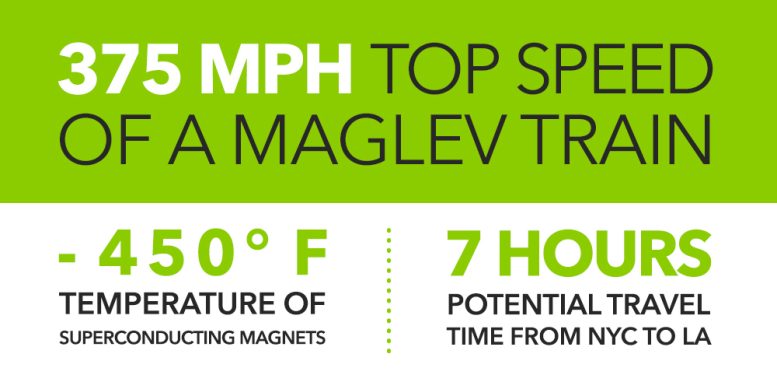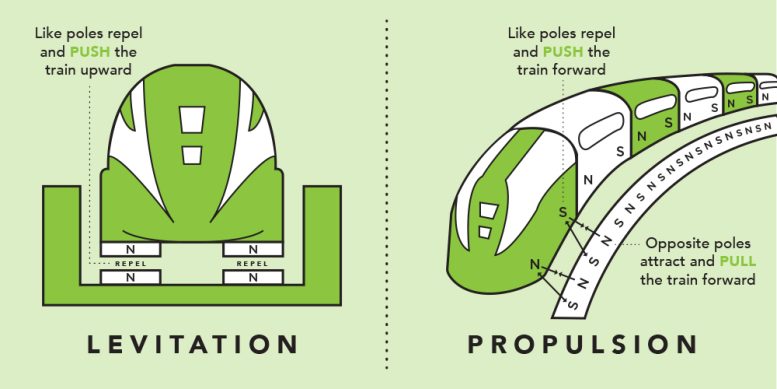Par

Crédit : Graphique de Carly Wilkins, Département de l’Energie.
Et si vous pouviez aller de New York à Los Angeles en un peu moins de sept heures sans prendre l’avion ? C’est possible grâce au train Maglev.
Les trains Maglev – abréviation de lévitation magnétique – trouvent leur origine dans une technologie mise au point au Brookhaven National Laboratory. James Powell et Gordon Danby de Brookhaven ont reçu le premier brevet pour un train à sustentation magnétique à la fin des années 1960. L’idée est venue à Powell alors qu’il était assis dans un embouteillage et qu’il pensait qu’il devait y avoir un meilleur moyen de voyager sur terre que les voitures ou les trains traditionnels. Il a eu l’idée d’utiliser des aimants supraconducteurs pour faire léviter un wagon de train. Les aimants supraconducteurs sont des électro-aimants qui sont refroidis à des températures extrêmes pendant leur utilisation, ce qui augmente considérablement la puissance du champ magnétique.

Illustration d’un train maglev futuriste.
Le premier train Maglev supraconducteur à grande vitesse exploité commercialement a été inauguré à Shanghai en 2004, tandis que d’autres sont en service au Japon et en Corée du Sud. Aux États-Unis, un certain nombre de trajets sont à l’étude pour relier des villes comme Baltimore et Washington, D.C.
Dans le Maglev, des aimants supraconducteurs suspendent un wagon de train au-dessus d’une voie de guidage en béton en forme de U. Comme les aimants ordinaires, ces aimants se déplacent dans un sens ou dans l’autre. Comme les aimants ordinaires, ces aimants se repoussent lorsque les pôles correspondants se font face.

These magnetic fields interact with simple metallic loops set into the concrete walls of the Maglev guideway. The loops are made of conductive materials, like aluminum, and when a magnetic field moves past, it creates an electric current that generates another magnetic field.
Three types of loops are set into the guideway at specific intervals to do three important tasks: one creates a field that makes the train hover about 5 inches above the guideway; a second keeps the train stable horizontally. Both loops use magnetic repulsion to keep the train car in the optimal spot; the further it gets from the center of the guideway or the closer to the bottom, the more magnetic resistance pushes it back on track.
The third set of loops is a propulsion system run by alternating current power. Here, both magnetic attraction and repulsion are used to move the train car along the guideway. Imagine the box with four magnets — one on each corner. The front corners have magnets with north poles facing out, and the back corners have magnets with south poles outward. Electrifying the propulsion loops generates magnetic fields that both pull the train forward from the front and push it forward from behind.
This floating magnet design creates a smooth trip. Even though the train can travel up to 375 miles per hour, a rider experiences less turbulence than on traditional steel wheel trains because the only source of friction is air.
Another big benefit is safety. Maglev trains are “driven” by the powered guideway. Any two trains traveling the same route cannot catch up and crash into one another because they’re all being powered to move at the same speed. Similarly, traditional train derailments that occur because of cornering too quickly can’t happen with Maglev. The further a Maglev train gets from its normal position between the guideway walls, the stronger the magnetic force pushing it back into place becomes.
This core feature is what’s most exciting to Jesse Powell. “With Maglev, there is no driver. The vehicles have to move where the network sends them. That’s basic physics. So now that we have computer algorithms for routing things very efficiently, we could change the scheduling of the entire network on the fly. It leads to a much more flexible transportation system in the future,” he said.
While this exciting technology isn’t deployed in the United States today, if Powell and his team get their way, you could someday be floating your way to your next destination.





